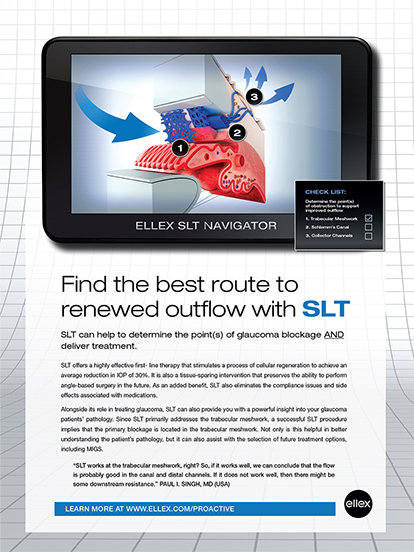As our understanding of dry eye disease (DED) evolves, so too must our creativity. Data from the Tear Film & Ocular Surface Society Dry Eye WorkShop reports, commonly called DEWS I and DEWS II, show that the multifactorial nature of DED requires multiple treatment options.1,2
Here we present two cases in which DED was successfully addressed with refractive surgery, an outside-the-box approach to treating a highly prevalent disease.
LASIK FOR DRY EYE
An optometrist referred a 23-year-old Hispanic woman for a refractive surgery consultation. The patient reported severe dryness and discomfort when she was wearing contact lenses, and her score on the Standardized Patient Evaluation of Eye Dryness (SPEED) questionnaire was 24/28. The patient reported that her only relief while wearing contact lenses was to use three drops of artificial tears every 30 minutes. She reported less dryness during spectacle wear, but she said she despised wearing glasses.
Upon examination, it was noted that the patient had inspissated meibomian glands, 50% gland dropout based on meibography with LipiScan (Johnson & Johnson Vision), and a 5-second noninvasive tear film breakup time as measured on the HD Analyzer (Visiometrics).
The patient underwent vectored thermal pulsation with LipiFlow (Johnson & Johnson Vision) and was started on cyclosporine ophthalmic emulsion 0.05% (Restasis, Allergan).
One month later, the patient returned with improved signs and symptoms, but still reported discomfort and a desire for improvement. After further discussion of treatment options, the patient chose to undergo LASIK to remove the iatrogenic component of DED, which, in this case, was her contact lens wear. At 1 month postoperative, the patient was ecstatic. Her VA was 20/15 in both eyes, and her SPEED score improved to 6/28. She was referred back to her optometrist for continued care.
Discussion
Contact lens–induced DED and contact lens–associated DED are major causes of iatrogenic DED.3 A study by Price et al showed less dryness in patients who underwent LASIK compared with patients who stayed in contact lenses.4 This is no surprise, as other studies such as PROWL-1 and PROWL-2 have demonstrated improvement in the symptoms of DED and the area of ocular surface staining after LASIK surgery.5 In fact, PROWL-1 demonstrated that 64.9% of patients with DED prior to LASIK had experienced resolution of symptoms at 6 months after surgery.5
PHAKIC IOLS FOR DRY EYE
A 28-year-old Hispanic woman presented for a refractive surgery consultation due to dryness during contact lens wear. Her SPEED score was 18/28. She was using cyclosporine to increase her wear time for daily contact lenses and an overnight ointment due to nocturnal lagophthalmos. Her spectacle prescription was -6.50 OU.
The patient was educated on options to treat her DED, and she elected to undergo bilateral implantation of phakic IOLs (Visian ICL, STAAR Surgical).
At her postoperative 1-month visit, the patient reported significant improvement in dryness. Her SPEED score improved to 4/28. She elected to discontinue use of cyclosporine and to continue use of ointment at night as needed.
Discussion
DED is known to be a main culprit in contact lens dropout: approximately 16% to 30% of all contact lens wearer each year report dry eyes as a main reason for not wearing contact lenses.6,7 Given these data, it is no surprise that patients with DED who are contact lens wearers frequently discontinue use and search for other options, such as refractive surgery, in lieu of spectacle wear.
CONCLUSION
These cases are examples that teach us that we must remember refractive surgery can often be an excellent treatment option for DED. Removing the iatrogenic component of the disease—that is, the patient’s contact lens wear itself— is a very effective solution to make your contact lens dropout patients engaged and happy with the comprehensive eye and vision care you provide in your primary eye care practice.
- The definition and classification of dry eye disease: report of the definition and classification subcommittee of the International Dry Eye WorkShop. Ocul Surf. 2007;2007(5):75-92.
- Craig JP, Nichols KK, Akpek E, et al. TFOS DEWS II definition and classification report. Ocul Surf. 2017;15(3):276-283.
- Gomes JAP, Azar DT, Baudouin C, et al. TFOS DEWS II iatrogenic report. Ocul Surf. 2017;15:511-538.
- Price MO, Price DA, Bucci FA Jr. Three-year longitudinal survey comparing visual satisfaction with LASIK and contact lenses. Ophthalmology. 2016;123:1659-5966.
- Eydelman M, Hilmantel G, Tarver ME, et al. Symptoms and satisfaction of patients in the patient-reported outcomes with laser in situ keratomileusis (PROWL) studies. JAMA Ophthalmol. 2017;135(1):13-22.
- Richdale K, Sinnott LT, Skadahl E, Nichols JJ. Frequency of and factors associated with contact lens dissatisfaction and discontinuation. Cornea. 2007;26:168-174.
- Sulley A, Young G, Hunt C, et al., Retention rates in new contact lens wearers. Eye Contact Lens. 2018;44 Suppl 1:S273-S282.







